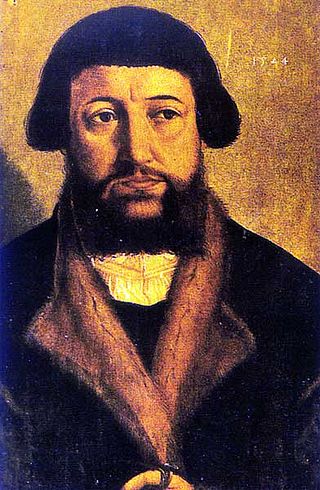
Thomas Cranmer was a leader of the English Reformation and Archbishop of Canterbury during the reigns of Henry VIII, Edward VI and, for a short time, Mary I. He helped build the case for the annulment of Henry's marriage to Catherine of Aragon, which was one of the causes of the separation of the English Church from union with the Holy See. Along with Thomas Cromwell, he supported the principle of royal supremacy, in which the king was considered sovereign over the Church within his realm.

Anne of Cleves was Queen of England from 6 January to 12 July 1540 as the fourth wife of King Henry VIII. Not much is known about Anne before 1527, when she became betrothed to Francis, Duke of Bar, son and heir of Antoine, Duke of Lorraine, although their marriage did not proceed. In March 1539, negotiations for Anne's marriage to Henry began, as Henry believed that he needed to form a political alliance with her brother, William, who was a leader of the Protestants of Western Germany, to strengthen his position against potential attacks from Catholic France and the Holy Roman Empire.

Thomas Cromwell, briefly Earl of Essex, was an English statesman and lawyer who served as chief minister to King Henry VIII from 1534 to 1540, when he was beheaded on orders of the king, who later blamed false charges for the execution.

Reginald Pole was an English cardinal and the last Catholic archbishop of Canterbury, holding the office from 1556 to 1558, during the Counter-Reformation.

Margaret Plantagenet, Countess of Salisbury, was the only surviving daughter of George Plantagenet, Duke of Clarence, a brother of Kings Edward IV and Richard III, by his wife Isabel Neville. As a result of her marriage to Richard Pole, she was also known as Margaret Pole. One of the few members of the House of Plantagenet to have survived the Wars of the Roses, she was executed in 1541 at the command of King Henry VIII, the second monarch of the House of Tudor, who was the son of her first cousin, Elizabeth of York. Pope Leo XIII beatified her as a martyr for the Catholic Church on 29 December 1886. One of her sons, Reginald Pole, was the last Catholic Archbishop of Canterbury.

William Warham was the Archbishop of Canterbury from 1503 to his death.

The Great Bible of 1539 was the first authorised edition of the Bible in English, authorised by King Henry VIII of England to be read aloud in the church services of the Church of England. The Great Bible was prepared by Myles Coverdale, working under commission of Thomas Cromwell, Secretary to Henry VIII and Vicar General. In 1538, Cromwell directed the clergy to provide "one book of the Bible of the largest volume in English, and the same set up in some convenient place within the said church that ye have care of, whereas your parishioners may most commodiously resort to the same and read it."

Katharina von Bora, after her wedding Katharina Luther, also referred to as "die Lutherin", was the wife of the German reformer Martin Luther and a seminal figure of the Protestant Reformation. Although little is known about her, she is often considered to have been important to the Reformation, her marriage setting a precedent for Protestant family life and clerical marriage.

Andreas Osiander was a German Lutheran theologian and Protestant reformer.
Thomas Norton was an English lawyer, politician, writer of verse, and playwright.

In common parlance, the wives of Henry VIII were the six queens consort of King Henry VIII of England between 1509 and his death in 1547. In legal terms, Henry had only three wives, because three of his marriages were annulled by the Church of England. However, he was never granted an annulment by the Pope, as he desired, for Catherine of Aragon, his first wife. Annulments declare that a true marriage never took place, unlike a divorce, in which a married couple end their union. Along with his six wives, Henry took several mistresses.
Margarete is a German feminine given name. It is derived from Ancient Greek margarites (μαργαρίτης), meaning "the pearl". Via the Latin margarita, it arrived in the German sprachraum. Related names in English include Daisy, Greta, Gretchen, Madge, Mae, Mag, Magee, Magdy, Magga, Maggie, Maggy, Maidie, Maisie, Marg, Margaret, Marguerite, Margarita, Margareta, Margarida, Marge, Margery, Marget, Margo, Margot, Marjorie, Marjory, Matge, May, Meg, Megan, Mairead, Mer, Meta, Rita, Molly, Peg and Peggy.
Events from the 1530s in England.
Sir Edward Saunders was an English judge and Chief Justice of the Queen's Bench.

Anne Locke was an English poet, translator and Calvinist religious figure. She has been called the first English author to publish a sonnet sequence, A Meditation of a Penitent Sinner (1560), although authorship of that work has arguably been attributed to Thomas Norton.
Stephen Vaughan (1502-1549) was an English merchant, royal agent and diplomat, and supporter of the Protestant Reformation.

Sir John Tregonwell was a Cornish jurist, a principal agent of Henry VIII and Thomas Cromwell in the Dissolution of the Monasteries. He served as Judge of the High Court of Admiralty from 1524 to 1536.

Edward Whitchurch was a London printer and publisher of Protestant works.
Isabel Leigh, Lady Stumpe was a lady-in-waiting during the reign of her younger half-sister, Catherine Howard, fifth wife and Queen Consort to Henry VIII.
Thomas Robertson was an English clergyman and Dean of Durham in the Tudor era.











